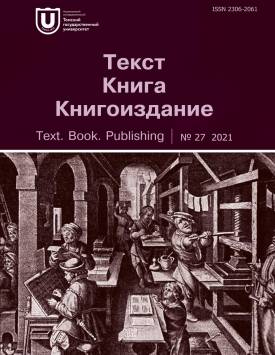The “Temple Cycle” in the Book of Poems by the Emigrant Poet Georgiy Golokhvastov as a Text in a Text
The article examines the artistic system of the book of poems Polusonety [HalfSonnets] by Georgiy Golohvastov, the ideological leader of a group of poets of the first wave of emigrants (E.V. Khristiani, D.A. Magula, V.S. Ilyashenko) that originated in the 1920s-1930s in New York. The article deals with the specific phenomenon of a “temple cycle” as a text in the text of Polusonety. The cycle can be specified by the author as a structural unit of the book, or it can “stand out” as a united text space based on thematic or figurative unity. The latter is our case. The object of the research is the realization in the half-sonnets of the image-code of the Temple, which is a symbol of Russian culture within the model of the poet’s world, the basis of the traditional world order reverently stored in the memory of the emigrant poet. The “temple cycle” is considered as a single lyrical text. The cross-cutting theme of the cycle is the Holy Rus, represented in the image of the world lucent Temple; this image is in the memory of every emigrant. The signs of the Temple in Golokhvastov’s half-sonnets are “dark lamps at the kiot”, “monk”, “poor temple with a wrecked bell tower”, “skete”. The poet voluntarily emigrated to the United States after the revolution of 1917, but his memory preserved the idyllic image of Cathedral Russia that shaped in his poetic system as the conceptual artistic and aesthetic model of the “Russian world” closely connected with the Orthodox faith. The poet perceived faith as the embodiment of spiritual coordinates of Russian people forced to live in a foreign land, associated it with images of monastery, cross, icons, monk in his poetry. These semiotic codes illustrate Golokhvastov’s “Russian thought”. The code of the Temple in Golokhvastov’s art system has various transformations: it is a lonely monastic skete, an ancient monastery, and a small city parish. The space of the Temple is individualized under the influence of the historical and cultural situation, psycho-mental characteristics, and personal experience of the author. The temple for Golokhvastov’s lyrical hero is a locus of gaining strength and peace of mind, in which he can get rid of loneliness among the hostile alien crowd. The altar, icons, and deacon’s singing remind the lyrical hero of his ancestral estate, where he “trembled in his chlid’s prayers.” The renewing and purifying space of Christian symbols leads him by prayer and uncomplicated contemplation. Staying in the space of the House of God, the lyrical hero regains the forever lost Holy Rus. We come to the following conclusions: the figurative world of Golokhvastov’s “temple cycle” is deeply consistent with the spirit of the Christian doctrine of God, which was represented by the poet in various lyrical forms and images throughout his creative life. Being a text in the text, this cycle extends the boundaries of the understanding of the emigrant poet’s artistic model and the integrity of his poetic system.
Keywords
monk, temple, Orthodoxy, cycle, Russian world, Rus, temple text, half-sonnetAuthors
| Name | Organization | |
| Strashkova Olga K. | North-Caucasus Federal University | olga.strashkova8@gmail.com |
| Alexenko Anastasiya D. | North-Caucasus Federal University | nastasya140@rambler.ru |
References

The “Temple Cycle” in the Book of Poems by the Emigrant Poet Georgiy Golokhvastov as a Text in a Text | Tekst. Kniga. Knigoizdanie - Text. Book. Publishing. 2021. № 27. DOI: 10.17223/23062061/27/1
